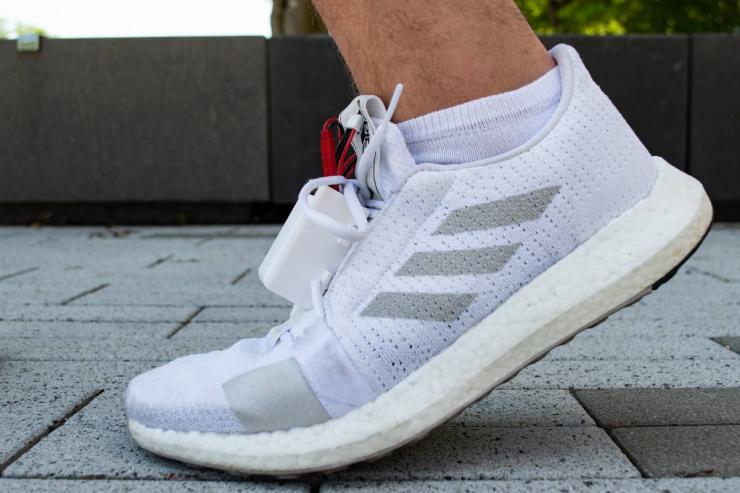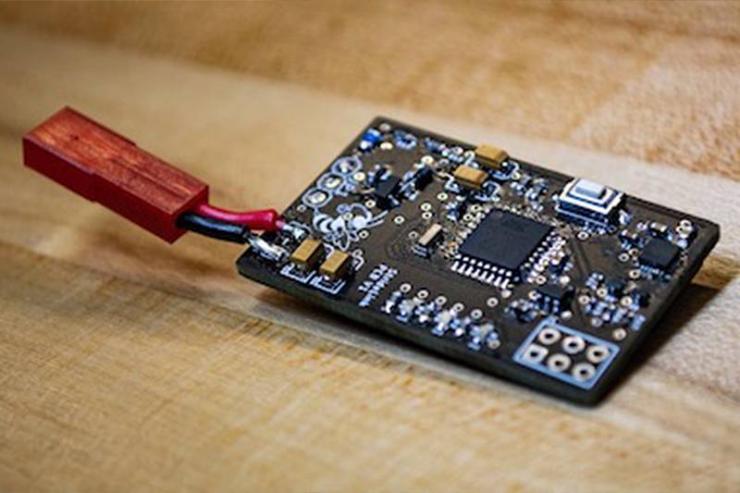CREATE-X Team Makes Big Strides with New Wearable Technology
Jan 20, 2022

On a typical day, Americans walk an average of 3,000 to 4,000 steps. For most people, walking is a natural act, and they don’t give it a second thought. However, although a single step can seem insignificant, the way people walk is actually a key indicator of overall health, injury, and recovery.
StrideLink, a new shoelace-sized wearable device created by Georgia Tech College of Engineering students, has the potential to advance standard physical therapy practices. With a unique step recognition algorithm, the device can collect more concrete data about an individual’s walking patterns. This can help physical therapists with a gait analysis, which is the study of the body’s motion to measure body movements, mechanics, and muscle activity.
Gait analysis can be important when making medical diagnoses and recovery plans, especially for stroke and cerebral palsy patients, in chiropractic practices, and more. Currently, gait analysis was measured only by the naked eye as physical therapists watched their patients walk and noted any patterns or errors, making the process highly subjective and prone to error.
“When many older people fall, it's really physically traumatic, in addition to greatly affecting their families and their quality of life,” said Marzeah Khorramabadi, a fifth-year computer engineering student and co-founder of StrideLink. “We took a step back and asked ourselves, ‘Why do geriatric patients fall?’ It all boils down to how we walk.”
Both of Khorramabadi's parents were entrepreneurs, inspiring her to pursue her own business venture one day. When it came time to make a college decision, the CREATE-X Startup Launch program drew Khorramabadi to Georgia Tech. CREATE-X’s Startup Launch is a program for Georgia Tech students who want to design and launch their projects into viable startups. Three years later, Khorramabadi and fellow co-founder Cassandra McIltrot created StrideLink and entered the Startup Launch.
“I actually started in computer engineering because I wanted to design things and start a business,” Khorramabadi said. “I really cared about creating a physical product that could make someone's life better.”
The road couldn’t have been more different for McIltrot, a fourth-year biomedical engineering student. She came to campus wanting to pursue medicine and research. Entrepreneurship was the last thing on her mind.
“During my freshman year, I thought I wanted to go to med school, but then I fell out of love with that idea and fell into love with more of the engineering side of things,” McIltrot said. “I actually liked creating new things and having an impact on a broader scale, so I stayed highly involved with research… but then the entrepreneurial world just came at me.”
Khorramabadi and McIltrot’s interests and backgrounds created a great match. During the summer of 2020, the two friends were sitting outside on a porch discussing McIltrot’s research related to the geriatric population’s high risk of falling.
“We thought to ourselves — why don't we do something about this?” McIltrot said. “We started with that small seed — the question ‘why do elderly people fall all the time?’ — and over a year later, we now have a real product to fix that technology gap.”
The journey leading to their first prototype, let alone the product that exists today, was not easy. The team faced three main challenges regarding the ideation, implementation, and execution of their gait tracking device.
“The first was understanding the customer to understand the regulatory constraints, as well as everything that goes on in that ecosystem. The second was designing [the device] right and figuring out what data can we get off of this thing. Finally, we asked ‘what can we do with that data and how can it be displayed in a meaningful way?’ Those three things were really hard,” Khorramabadi said.
Before even attempting to design a product, Khorramabadi and McIltrot spent six months researching and interviewing various physical therapists. They wanted to understand how they conducted gaited analysis without any aiding technology and what their needs were.
“A lot of people design first without talking to their customer, but that's the biggest mistake you can make,” Khorramabadi said. “In fact, it's a guaranteed mistake if you are an engineer designing for someone in a completely different profession, like healthcare, because you really don't understand what you think you do.”
StrideLink in Action
As the duo completed their research and had a design in mind, they recruited team members Neel Narvekar (CmpE ‘21) and Tony Wineman (EE ‘21), who then made quick progress with developing the prototype and creating the hardware’s wearable technology.
“Everyone at the Hive, the Electrical and Computer Engineering maker space, knows Neel. He knows how to use all of the machines, and if he doesn't know how to do something, he'll figure out how to do it in 30 minutes,” Khorramabadi said.
With Narvekar’s natural gift of creating, the team built their own casing, electrical design, and wrote their own firmware for their gait tracking device. Combined with Wineman’s experience in electrical engineering, the team created a custom-printed circuit board for the device, bringing the team’s vision to life.
“Because of them, we've had really stable hardware to base our software and our signal processing off of. That definitely made the biggest difference because a lot of the things that we've been able to achieve and develop out with this StrideLink device has been a result of us having custom, stable hardware,” Khorramabadi said.
Once the team had a physical device, the next challenge was testing it. While attached to the shoelace of a user, StrideLink was able to record gait cycle time and time spent in different phases of walking using unique step recognition algorithms designed by Khorramabadi. Previously, when gait analysis was conducted with the naked eye, these time measurements would be recorded manually.
Since these actions take mere milliseconds to complete, the naked eye cannot measure these movements accurately enough to compare to Stridelink’s collected data. The only device that Stridelink could be tested against was a $40,000 gait system in a lab. When the team finally tested StrideLink against that system, the margin of error was much lower than expected.
“We built this device for less than $100 in four months with a team of undergrads, and we were getting comparable results to a $40,000 system that's been the gold standard for over 20 years,” said Khorramabadi. “That’s something that you don't really expect when you're designing a device that early on.”
Future of StrideLink
After winning the “Best Overall Project” prize at this past spring’s 2021 Capstone Design Expo, and entering the CREATE-X Startup Launch, the team is working on refining their device based upon feedback from local clinics that are piloting the device. They hope the technology will ultimately allow physical therapists to have better communication with their patients by giving them more substantial data to shape their treatment plans.
For both Khorramabadi and McIltrot, accessibility to their new invention is one of their biggest motivators to continue developing the device, especially in a world of increasing telehealth appointments.
“We see this as a device that could eventually be in every physical therapy clinic. Someday, patients could be sent home with exercises and a StrideLink that tracks progress at home, while also allowing for better communication with their therapist,” McIltrot said.


